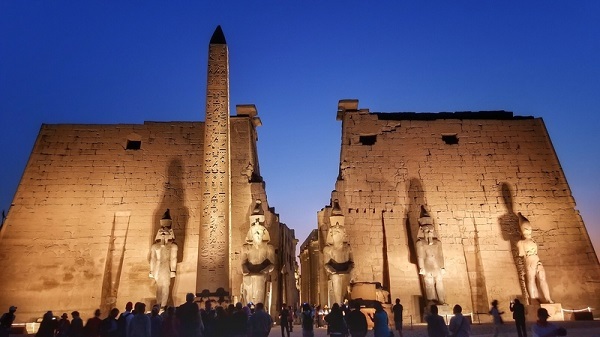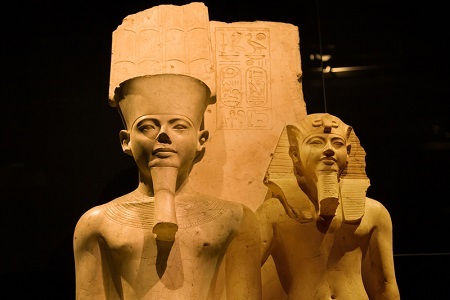

The Luxor Temple is an ancient Egyptian temple complex located in the city of Luxor (ancient Thebes) in Egypt. The temple is dedicated to the god Amun, his consort Mut, and their son Khonsu. It was originally connected to the nearby Temple of Karnak by an avenue of sphinxes and was also used as a center for the worship of the royal family, particularly the pharaohs who built it. The temple underwent several expansions and renovations over the centuries, was buried by sand and debris for many centuries, and was rediscovered in the 19th century CE.

The Luxor Temple was not only a religious center for the worship of the god Amun and his family, but it also served as a center for the worship of the royal family, particularly the pharaohs who built it.
The temple also served as a location for important religious festivals and ceremonies, such as the Opet Festival, which was celebrated annually in honor of Amun and his consort Mut.
The Luxor Temple complex also includes a number of smaller structures, such as the Temple of Ramses III and the Temple of Khonsu, which were built and dedicated to other gods and pharaohs.
The Luxor Temple also contains a number of significant inscriptions and hieroglyphs, including the famous "Dream Stele" of Thutmose IV and Ptolemaic inscriptions, which offer a glimpse into the religious beliefs and practices of ancient Egypt.
The Luxor Temple is now a UNESCO World Heritage Site and a popular tourist attraction.
The Luxor Temple was built during the New Kingdom period, around 1400 BCE, making it over 3,000 years old.
Despite its age, the temple has been well-preserved over the centuries, and many of the original colors and decorations are still visible.
The temple was active for over a thousand years, and parts of it were still in use during the Roman period, which is evident by the presence of Roman inscriptions and decorations in the temple.
Due to its age and historical significance, the temple has undergone several renovations and restorations over the years by various pharaohs, Ptolemies, and the Roman emperors.
After the temple was buried by sand and debris for many centuries, it was rediscovered in the 19th century CE by the French archaeologist, Auguste Mariette.
The Luxor Temple was built by several pharaohs of the New Kingdom period, including Amenhotep III and Ramses II.
Amenhotep III built the temple's original structure and its main pylon, while Ramses II added the courtyard and the two obelisks that still stand today.
The temple was also expanded and renovated by later pharaohs, such as Ptolemy VI and Ptolemy XII. These pharaohs added their own inscriptions and decorations to the temple, which reflect the political and religious changes of their reigns.
The temple was also used by the Roman emperors, who added their own inscriptions and decorations to the temple, this is evident by the presence of Roman inscriptions and decorations in the temple
The temple was also used as a quarry for building materials in later centuries, which further protected it from looting and destruction.
The Luxor Temple features a number of architectural elements that are typical of ancient Egyptian temples, such as pylons, courtyards, and hypostyle halls.
In later centuries, the pylon, which is the entrance to the temple, was a massive structure made of sandstone that was decorated with reliefs depicting the pharaohs and gods of the temple.
The courtyards are open spaces surrounded by columns and enclosed by walls that were used for rituals and ceremonies.
The Hypostyle hall is a massive chamber with a roof supported by columns, it is one of the most impressive architectural elements in the temple, it was used for religious ceremonies and rituals.
The temple is built of sandstone, and many of the original colors and decorations are still visible. The temple was decorated with intricate carvings, hieroglyphs and paintings, depicting the pharaohs and gods of the temple.
The temple features a number of statues and reliefs, including a large statue of Ramses II that once stood at the entrance.
Finally, the Luxor Temple is a magnificent architectural and historical Egyptian treasure. Built during the New Kingdom period in 1400 BCE, this temple complex, dedicated to the god Amun, his consort Mut, and their son Khonsu, is one of the most important and well-preserved temples of ancient Egypt. Despite being buried by sand and debris for many centuries, the temple was rediscovered in the 19th century CE and is now a popular tourist attraction, offering a glimpse into the grandeur and religious practices of ancient Egypt.

God Amun and King Horemheb statue
Q1. What is the significance of the avenue of sphinxes that connects the Luxor Temple to the Temple of Karnak?
Ans. The avenue of sphinxes is a unique feature of the Luxor Temple complex, it connects the temple to the nearby Temple of Karnak and was used as a processional way during religious festivals and ceremonies.
Q2. What is the significance of the "Dream Stele" of Thutmose IV?
Ans. The "Dream Stele" of Thutmose IV is a significant historical and religious artifact that was discovered at the Luxor Temple. It is an inscribed stone slab that tells the story of how the pharaoh Thutmose IV had a dream in which the god Amun appeared to him and promised to make him king if he cleared the sand that was blocking the temple of the god.
Q3. What is the significance of the Ptolemaic inscriptions at the Luxor Temple?
Ans. The Ptolemaic inscriptions at the Luxor Temple are significant because they provide evidence of the temple's continued use and renovation during the Ptolemaic period. The Ptolemies were of Greek descent, but they ruled Egypt as pharaohs after the death of Alexander the Great.